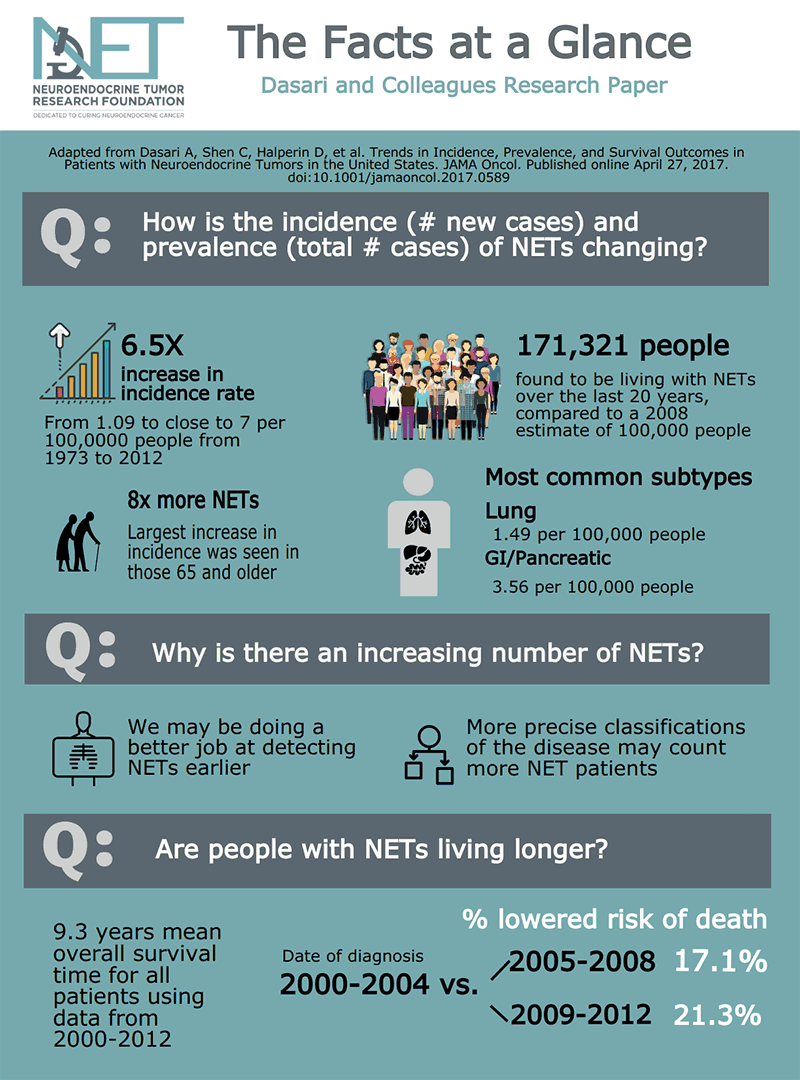Why all these findings may be good news
A long-awaited epidemiological study just published in JAMA Oncology shows progress in the early detection of neuroendocrine tumors (NETs) and improvements in overall survival in the U.S. over many decades.
Arvind Dasari, MD, and colleagues from the University of Texas MD Anderson Cancer Center found steep increases in the rates of NETs across all sites, stages, and grades, with the largest increases occurring in the earliest stages and grades. They also found improvements in overall survival for all NET patients over time.
Earlier identification of NETs
“The paper by Dasari and colleagues shows some very interesting findings that might change how we approach the treatment of NETs in the clinic,” said Effie Tzameli, PhD, Director of Research, NETRF. “As noted by the authors, better diagnostic and imaging tools catch the disease at an earlier stage and often before metastasis, resulting in better prognosis and increased survival.”
“We saw the incidence trend, according to stage, to be the highest for the localized stage, or grade one, and that, in large part, is probably because of better classification and recognition of these tumors pathologically,” said Arvind Dasari, MD, first author of the paper.
“It will be interesting to see how these new data will impact the management of early stage disease, in the future,” said Dr. Tzameli.
Making the case for increased attention to NETs
“I think the most important thing this paper does is help us articulate the size and scale of the NET problem to help us position and articulate how important this is on a population level,” said co-author Dan Halperin, MD, MD Anderson Cancer Center, who is also a NETRF-funded researcher.
Another NETRF-funded researcher, Pamela Kunz, MD, Stanford University, contributed an invited commentary on the Dasari paper for JAMA Oncology. “NETs were once considered rare and unworthy of scientific study or funding.” Kunz wrote. “The study by Dasari and colleagues and others have hopefully put this notion to rest and serve as our call to arms.”
Increased survival expands number of people with NETs
The study also evaluated trends in overall survival. Using 2000-2004 as the comparison time period for diagnosis, the risk of death decreased for those diagnosed from 2005 to 2008 and 2009-2012, with the most notable improvements in survival for distant GI and pancreatic NETs. Traditionally pancreatic NETs were thought to have a worse prognosis, compared to other NETs, but these data put it on par with other NETs.
This could be due to the fact that we are noting more earlier stage diseases that do better anyway, said Dr. Dasari, “But we believe that a large part of the improvement is related to improvement in treatment modalities during this period.”
“Improvement in survival makes a big difference in people’s live,” said Dr. Halperin. “The proof is in the pudding as we brought new therapies to bear, it was worth it. We need to continue to invest in NETs.”
About the study
This retrospective population-based study of 65,000 patients with NETs between 1973 to 2012 used data from the National Cancer Institute’s Surveillance, Epidemiology, and End Results (SEER) program. Dasari and colleagues noted the limitations of the study. SEER data does not include certain patient characteristics, specify the functional status of a tumor, and many NETs are not captured by the SEER database. The population size included and the duration of the study help make its findings meaningful and comprehensive. This paper follows the seminal 2008 article by one of its co-authors, James C. Yao, MD, which documented the number of Americans living with this disease for the first time.
Citation for published paper: Dasari A, Shen C, Halperin D, Zhao B, Zhou S, Xu Y, Shih T, Yao JC. Trends in the Incidence, Prevalence, and Survival Outcomes in Patients With Neuroendocrine Tumors in the United States. JAMA Oncol. Published online April 27, 2017. doi:10.1001/jamaoncol.2017.0589
Listen to an interview with principal investigator Arvind Dasari, MD.

